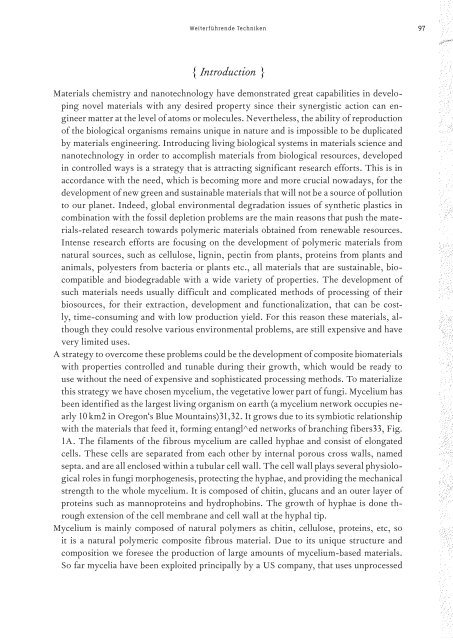Logbuch_17x24Druck_einzelseiten
Create successful ePaper yourself
Turn your PDF publications into a flip-book with our unique Google optimized e-Paper software.
Weiterführende Techniken<br />
97<br />
{ Introduction }<br />
Materials chemistry and nanotechnology have demonstrated great capabilities in developing<br />
novel materials with any desired property since their synergistic action can engineer<br />
matter at the level of atoms or molecules. Nevertheless, the ability of reproduction<br />
of the biological organisms remains unique in nature and is impossible to be duplicated<br />
by materials engineering. Introducing living biological systems in materials science and<br />
nanotechnology in order to accomplish materials from biological resources, developed<br />
in controlled ways is a strategy that is attracting significant research efforts. This is in<br />
accordance with the need, which is becoming more and more crucial nowadays, for the<br />
development of new green and sustainable materials that will not be a source of pollution<br />
to our planet. Indeed, global environmental degradation issues of synthetic plastics in<br />
combination with the fossil depletion problems are the main reasons that push the materials-related<br />
research towards polymeric materials obtained from renewable resources.<br />
Intense research efforts are focusing on the development of polymeric materials from<br />
natural sources, such as cellulose, lignin, pectin from plants, proteins from plants and<br />
animals, polyesters from bacteria or plants etc., all materials that are sustainable, biocompatible<br />
and biodegradable with a wide variety of properties. The development of<br />
such materials needs usually difficult and complicated methods of processing of their<br />
biosources, for their extraction, development and functionalization, that can be costly,<br />
time-consuming and with low production yield. For this reason these materials, although<br />
they could resolve various environmental problems, are still expensive and have<br />
very limited uses.<br />
A strategy to overcome these problems could be the development of composite biomaterials<br />
with properties controlled and tunable during their growth, which would be ready to<br />
use without the need of expensive and sophisticated processing methods. To materialize<br />
this strategy we have chosen mycelium, the vegetative lower part of fungi. Mycelium has<br />
been identified as the largest living organism on earth (a mycelium network occupies nearly<br />
10 km2 in Oregon‘s Blue Mountains)31,32. It grows due to its symbiotic relationship<br />
with the materials that feed it, forming entangl^ed networks of branching fibers33, Fig.<br />
1A. The filaments of the fibrous mycelium are called hyphae and consist of elongated<br />
cells. These cells are separated from each other by internal porous cross walls, named<br />
septa. and are all enclosed within a tubular cell wall. The cell wall plays several physiological<br />
roles in fungi morphogenesis, protecting the hyphae, and providing the mechanical<br />
strength to the whole mycelium. It is composed of chitin, glucans and an outer layer of<br />
proteins such as mannoproteins and hydrophobins. The growth of hyphae is done through<br />
extension of the cell membrane and cell wall at the hyphal tip.<br />
Mycelium is mainly composed of natural polymers as chitin, cellulose, proteins, etc, so<br />
it is a natural polymeric composite fibrous material. Due to its unique structure and<br />
composition we foresee the production of large amounts of mycelium-based materials.<br />
So far mycelia have been exploited principally by a US company, that uses unprocessed


